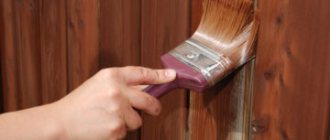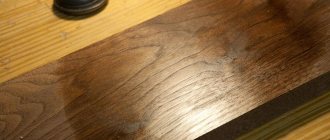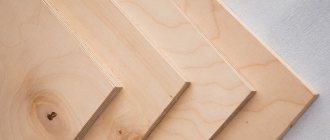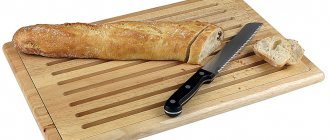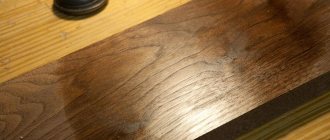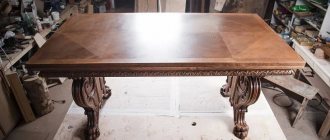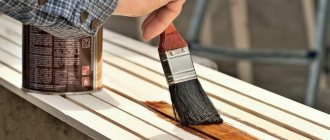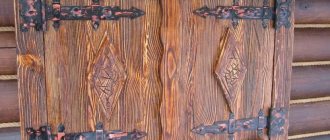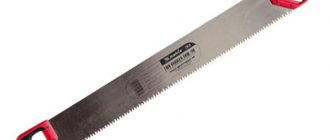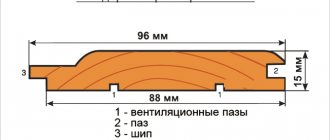Both in ancient times and nowadays, wood was especially popular due to its naturalness and accessibility. Log huts, utensils, dishes, and household items made of wood will give a head start to newfangled plastics. Thanks to living material, comfort, tranquility, kindness and grace appear.
However, without special care, the tree will not last long. In order to protect it from all kinds of harmful insects, excessive humidity and fungal diseases, special products such as varnishes and stains were created. Treatment with these preparations does not allow excess moisture, bright light, scratches, dirt and other unfavorable factors to damage the appearance of wooden products, while maintaining nobility, beauty, sophistication, richness and naturalness.
- How to apply
- How to apply
- How to apply
How to choose a stain
Stain (in professional slang - “stain”) is a specially made coating for wooden products, the main difference of which from other means is preserving the structure of the natural material and emphasizing its naturalness. The stain consists of a pigment and a base (oil, alcohol, water). Water-based bases using acrylic resins are considered the most popular. In addition to decorative qualities, they have excellent antiseptic properties.
Coating wood with stain
There are wax stains. The thin film resulting from its use will not only give the tree additional decorativeness, but will also become an excellent barrier to water. The choice of stain should be approached very seriously, paying attention to the following criteria:
| Criteria | Description |
| What kind of work is wood used for (internal or external) | If wood is used for exterior cladding, then attention is paid to the presence of pigments that prevent ultraviolet rays from adversely affecting wooden structures. |
| Safe composition in terms of impact on the human body | If you need to stain wooden objects located in the children's room, carefully study the composition so that it does not contain harmful compounds and components. It is advisable to give preference to wax, oil or water-based stains. |
| Ready-made stain or in powder form | Alcohol and water-based stains can have a dry appearance. They are diluted at home, immediately before use. If you have doubts about the positivity of the result obtained, you should purchase a finished product. |
| Stain surface coating options | When using alcohol stains, you must use a spray gun. This will make it possible to evenly apply the composition to the wooden surface, since certain difficulties may arise associated with the significant drying speed of such a composition. If we are talking about small areas to be covered, then you can use brushes, fabric or foam swabs. Significant volumes are covered with stain using special sprayers. |
| Design requests and visions | The sample you see at a retail outlet does not always correspond to the actual result; the color may differ. This is influenced by the available lighting in the retail space, the structure of the wood used and its species. Products from different batches of stain may also have different shades. |
Color spectrum
Do-it-yourself - How to do it yourself How to treat a bathhouse
Today, a range of similar products for coating and painting wooden surfaces can satisfy the needs of every customer. Such products allow the craftsman to give the wood almost any color. Recently, black stain has been in demand among specialists, which gives the treated surface the appearance of a black mirror. The technology for applying the black composition requires preliminary polishing of the base.
Shades of gray will help the surface blend harmoniously into the interior of any room. However, the use of this color will be successful only if the walls and interior items in the room are bright. Gray color can cause apathy, and products painted in this color will be lost against the background of the rest of the decoration.
According to psychologists, the most optimal color for a person is green. It evokes positive emotions and is suitable for painting walls and ceilings, as well as furniture and other things.
The blue color gives expressiveness and depth to the processed product. A stain of this color will go well with white and yellow tones.
In addition to multi-colored compounds, there is a colorless impregnation on store shelves, which makes it possible to preserve the natural color of the material.
The final color of the wood depends on the number of layers applied, so experts advise making a final decision only after a test painting. The material for test painting is sanded and cleaned. Next, proceed to applying the first layer of the composition. After it has completely dried, a second layer is applied, but to a smaller area. The third layer is used to process the material on a section of wood that will be even smaller than the space allocated for the two previous layers of stain.
When all areas are completely dry, comparing the results obtained, you can choose the color you like.
What is stain used for?
Stain is primarily used to give wood the desired shade without changing its texture or pattern. Stain also makes it possible to emphasize the aesthetics of a natural material, enhance it, refine it, and give it more charm. For example, by covering pine with a special stain, you can get the visualization of dark oak or other wood.
Examples of wood stain colors
Despite the strength of the material, all wooden products are susceptible to the negative effects of adverse factors associated with the appearance of fungus. Different types of stains differ in their composition. The main positive characteristics of the coating include:
- protection from the harmful effects of ultraviolet rays;
- moisture protection function;
- the ability to protect against harmful insects;
- makes wood lighter;
- gives the tree its original appearance, eliminates errors;
- increases service life;
- promotes compaction of the wood structure;
- It is considered a preparatory measure before painting or varnishing wood.
There are types of stains that are created exclusively for covering wooden surfaces located indoors. These are countertops, furniture, interior doors, floors. Special stains are made to be used externally. For example, to cover a wooden floor and steps on an open veranda. Some compositions cover the wooden surface with a thin layer, others penetrate deeply into the structure. Modern stains can not only decorate the surface of wood, but also make it multi-colored and give the wood a certain uniqueness.
Rules for using equipment
The instrument is set up after filling the tank with the emulsion diluted in accordance with the instructions; the lid of the container should be tightly closed. First, adjust the release of air and paint: by pressing the trigger, direct the jet to the newspaper and move it from side to side to understand at what distance and at what intensity a uniform coating will be obtained.
When working, you need to use personal protective equipment - a mask, goggles, high gloves, an apron. Initially, you should prepare the surface for painting, if necessary, dilute the composition with a solvent (if this step is provided for in the instructions). Painting begins with the least important area in order to get used to the functionality of the tool. Important: the room must be ventilated; if work is carried out outdoors, you must choose a windless area.
How to apply stain
There are several tools for applying stain:
- spray gun;
- wide brush;
- roller;
- rags;
- sponge;
- lint-free fabric, etc.
Methods of applying stain
The choice of application method depends on the area, volume, characteristics of the material, as well as the type of stain itself.
For example, if a large room will be treated, then a spray gun would be the best option. It is also recommended to use it for alcohol solutions and nitro stains.
In addition to the spray gun, you can use a roller; working with it will also be faster than working with a brush or rag.
Small volumes can be done with a brush, sponge, rags, etc. They are also preferable for use with oil, acrylic and water-based stains. The main thing is that there is no lint, threads, dust, etc. left from them.
Which spray gun to choose: overview of key criteria
In the electric series, the ratio of motor and gun parameters is selected at the factory, so the choice here does not affect such a parameter as the type of device. For pneumatic variations, on the contrary, you need to buy a working attachment yourself.
Types of working pistols
According to this criterion, manufacturers offer 3 options:
- The paint is supplied under high pressure, everything happens very quickly. Substance losses do not exceed 50%, devices are sold in a loyal price segment, but do not provide high quality coating;
- They operate in low pressure mode, here increased air flow occurs, so 65% of the paint settles on the surface being treated;
- They also work with low pressure, which contributes to minimal loss of emulsion - no more than 20%.
The third category is sold in the high price segment, but the costs are quite reasonable - the equipment provides excellent quality coverage.
Pressure
The higher this indicator, the faster the paint layer is applied, but in this case the loss of the emulsion increases. The best option may be a model operating at a pressure of 4-6 atmospheres; in this case, there are no restrictions on the structure of paints and varnishes.
Power
This indicator is important for electric series: all sprayers in this segment, the power of which does not exceed 500 W, are household. They are characterized by uneven coverage and are difficult to use with thick formulations. But they are optimal for one-time work, as they are inexpensive.
The performance of pneumatics is determined by the performance of the compressor; here the power varies between 0.7-3 kW.
Wall-mounted additions
Tanks fixed to the gun are installed from below or from above. The latter are made of nylon or plastic, although their volume rarely exceeds 1 liter, they are difficult to work with, since the center of gravity of the unit shifts. Containers attached to the bottom are more convenient; they are made of metal.
The outlet diameter of the nozzle is usually 1-3 mm; the most popular are nozzles in which the hole dimensions are in the range of 1.4-1.7 mm. To apply putty you will need nozzles with an output diameter of 6-7 mm.
Recommendations from experts
When choosing a spray gun for painting and varnishing wood, professionals recommend adhering to several rules:
- if one-time work is planned or whitewashing is to be applied, a simple mechanical spray gun will be sufficient. To save suspension, it is worth choosing a plunger model;
- for those who will deal with paints and varnishes every day, for example, for carpenters and finishers, pneumatic variations with an LVLP or HVLP gun type, equipped with an additional tank, will be appropriate;
- Air electric units are excellent for treating large areas, as they are undemanding in maintenance, exhibit high quality application, and operate from a standard power supply.
If you plan to work in a tight space, battery-powered devices are more convenient. They need to be chosen so that one recharge lasts for at least an hour.
Types of wood stains and methods of applying them
There are many varieties of stain, they mainly differ in composition and purpose. The main types are as follows.
Alcohol stains
They contain aniline dyes diluted with alcohol. They have a wide range of different shades. Sold in powder and liquid form. The powder must be dissolved before application.
Alcohol stain
How to apply
Alcohol-based stains dry out quite quickly, so the coating should be applied quickly and efficiently. In 30 minutes, the stain completely penetrates the wood. The use of brushes, tampons and rollers should be avoided: their use may cause stains, uneven coverage, and other defects. A spray gun will be an excellent assistant. The result will be optimal.
Applying stain with a spray gun
Alcohol stains are mainly used to cover large wooden surfaces. They are easy and quick to apply and dry quickly. Currently, they produce their analogue - nitromortars, the dilution of which uses solvents.
Water stains
As a rule, they are used for indoor work. They have virtually no pungent odor or toxicity. But they are famous for their excellent adhesion, they are able to penetrate deeply into the structure of the tree, and advantageously emphasize its structure. The color range of this stain is quite extensive. You can purchase the product in powder or liquid form.
Water stain
How to apply
The drying process takes a long time (about 14 hours). The negative aspects include the lack of uniformity when covering larch. When treating a painted surface with such a stain, stains may appear. To avoid this, you should first clean the tree of resin. It is possible that the pile may rise, which requires additional processing before painting begins: the surface is completely wetted with clean water and then thoroughly sanded.
Oil stains
This type involves dissolving pigments in oil. The most commonly used oil is flaxseed oil. By using such a product, the surface of the wood is evenly coated.
Uniform application is achieved mainly due to the presence of linseed oil in the stain. This composition is not afraid of direct sunlight, does not lose its original appearance, is resistant to ultraviolet radiation, and retains color saturation for quite a long time.
Oil stain
How to apply
The composition is perfectly applied in a variety of ways, including with a spray gun. A roller, brushes and tampons will do. In 3 – 4 hours such stains are able to dry completely. However, everything depends on the level of their concentration, ambient temperature and humidity.
Oil stains may become thick after a certain time. To give them the necessary consistency, the product should be diluted. Often a special solvent is used - white spirit.
Wax and acrylic stains
They are based on acrylic or wax resins. Their characteristics resemble oil compositions. Their distinctive feature is the ability to repel water. Thanks to this coating, the pores are closed and moisture cannot enter the wood. The color palette of acrylic and wax stains is impressive. You can choose a shade to suit every taste and imagination.
Acrylic stain
How to apply
The solutions fit perfectly onto the surface using any manual method convenient for a person. However, you should refuse the spray gun. The solutions create a uniform shade and do not contribute to raising the pile. If the product works well and correctly, stains and other defects will not occur. This type of stain dries in about 5 hours. Such preparations are used to restore damaged pieces of furniture.
Pros and cons of different types of stain
Types of tinting products
The main advantage of treatment with a tinting composition is the aesthetic aspect (the material takes on a decorative appearance). But there are other advantages: increased service life due to the antiseptic effect, preservation of texture, absence of toxic substances, the ability to combine different tones and colors, good adhesion to the processed wooden object, increased resistance to a humid environment, ease of use.
The process of treating with stain depends on its type; the classification includes several main types of tinting material:
- Water stain is the most budget-friendly and non-toxic option suitable for interior decoration. The compositions are sold in ready-made diluted form, or in powder form, which must be diluted with water. Water-based compositions are available in a wide variety of colors. The drying process is relatively long – up to 14 hours. Resinous species must be deresined before processing, wood with raised pile must be sanded. Powder compositions must be diluted with warm water. To make the solution a shade lighter, add a little more water.
- Alcohol stain - consisting of an alcohol base and aniline dye. The product is also available in two states: dry and liquid. Unlike water-based stains, dry substances are diluted with alcohol. In general, in order not to confuse what to dilute with, you need to carefully study the instructions. Alcohol stains dry much faster - in half an hour. Attention! When working with these solutions, ventilate the room, otherwise you will get poisoned by inhaling the vapors. The evaporation process lasts only 30 minutes, so during this time there will be a maximum concentration of toxic substances from denatured alcohol.
- Oil stain - characterized by resistance to ultraviolet radiation, the solution is based on oil (often linseed), so the richness of the pigments remains for years. How long such a composition dries depends on the concentration, temperature, and other factors. On average, the period is within 2-4 hours. Application is even easier, the result is the most uniform layer possible, the pile does not rise.
- Acrylic or wax - with excellent moisture-proof properties. But the coating is not protected from mechanical damage. The compositions are applied easily, without streaks, and maintain the same tone. The choice of colors is wide, well suited for restoration work on parquet and furniture. A whole range of factors influence how long it takes wood stain to dry, but the average time for complete drying is between 4 and 5 hours.
- Nitromortar – similar in properties and method of application to alcohol stain. They need to quickly cover wooden structures; a good option is to use sprayers.
What to apply?
For staining at home, use brushes, foam sponges, swabs made of soft absorbent fabric, ordinary paint rollers, and spray guns. The choice of tools and equipment is influenced by the type of composition and its drying time.
Water stains are applied with a brush, roller, swabs; for alcohol and nitro stains, spraying with a spray gun is recommended - this way the consumption is more economical, the quality of the coating is several times higher. For oil and acrylic compositions, lint-free cloth swabs and wide brushes are equally good for application.
Preparing a wooden surface before applying stain
Any work, even the most basic one, requires certain efforts, dexterity, minimal skills, and accuracy. Using stain is not as simple as it seems at first. If in the process of work you do not take into account the subtleties and nuances, the order of actions, you may not achieve a positive result.
Initially, you need to decide on the shade and purchase the necessary tools for application. It is advisable to apply quick-drying compounds with a spray gun or other suitable sprayer. Sponges, swabs and brushes must be purchased to work with acrylic, water-based or oil-based stains. The size of the treated area is of no small importance. The wooden surface must first be cleaned, dried, and only then covered with the composition.
After complete drying, the product is carefully processed with sandpaper or a grinder. To avoid the appearance of defects, hand movements must be directed along the fibers. Scratches, chips, and depressions on the surface that were not noticed in time can be clearly visible after opening with stain. Using a grinding machine, the surface is made completely smooth.
Sanding wood
Using napkins or a vacuum cleaner, the wooden surface is freed from trimmed fibers and dust. Afterwards, the degreasing process is carried out using white spirit. When using a water-based stain, the surface is pre-wetted with clean water. Then it is sanded again.
If you have to work with coniferous species, then they have their own nuances. The presence of resinous places will make itself felt after treating the object with stain, and terrible stains will appear. It is advisable to avoid such misunderstandings by using the following methods before applying stain:
- Mix 750 ml of water and 250 ml of acetone. Wipe the surface with the solution.
- Stir 50 g of potassium carbonate and 60 g of soda ash in a liter of warm water. Walk the mixture over the surface of the wood.
To completely disappear the resinous areas, the procedure is carried out a couple of times. Afterwards, the surface is cleaned with soap and then just clean water, dried and covered with stain.
How to cover wood with stain - basic rules
In addition to the recommendations described above, there are also universal rules for working with stain:
- For better adhesion, it is recommended to preheat the stain to 35-38°C.
- If you are not sure whether the stain will work or not, it is better to first try it on a similar unnecessary piece of wood. And it is advisable to do this in several layers.
Example of test application of stain in 1, 2 and 3 layers - There is no need to heavily wet the brush, roller, swab, etc. stain, otherwise smudges may remain on the material, and the solution itself will be distributed unevenly.
- The stain is usually applied along the grain of the wood. If you are using a tampon, you can do this in a circular motion.
Applying stain with a rag - Vertical surfaces (windows, doors, walls, fences, etc.) are covered with stain from bottom to top to prevent unnecessary smudges.
- You need to work carefully, trying to paint everything evenly, but as quickly as possible - no downtime or interruptions are allowed, otherwise the texture will turn out uneven and with spots.
- If excess or smudges have formed, they must be quickly wiped off along the grain.
- The first (and subsequent) coats should be allowed to dry thoroughly before applying the second. Drying times are usually written on the product label. Depending on the type of stain, this is from half an hour to half a day.
- The stain application process can be repeated several times, layer by layer, until the desired color is achieved.
Useful videos and master classes on the topic:
Dyeing technology
How to stain wood correctly? You should work at an air temperature above +15°C, this will allow the stain to penetrate deep into the pores of the wood. Manufacturers recommend that before applying the base substance, cover the surface with conditioner of the same brand. The stain should be mixed thoroughly so that the dye does not remain on the bottom or walls of the vessel. When using any tool (brush, roller or sponge), a sufficient amount of stain should be applied to the surface. Let it be better to have an excess (it can be removed after staining) than a deficiency.
When processing a vertical surface, you need to work with movements from bottom to top. If you are staining a horizontal part, you must first move the brush along the grain of the wood, then across it, then again along it. This way you can achieve uniform application and avoid unnecessary smudges.
Staining one part or surface must be done in one go, without interruptions. Otherwise, spots and uneven coloring may appear.
To obtain an even tone and a high-quality result, the staining process is repeated several times. Each subsequent layer is applied only after the previous one has completely dried. How long does it take for stain to dry? The drying time depends on many factors: the composition of the stain, the ambient temperature, the degree of humidity of the base. On average, alcohol-based compositions dry in 1-2 hours, aqueous solutions - at least a day.
After the impregnation has completely dried, the surface is subjected to the final stage of wood processing, which is called washing. This action removes excess stain that the tree did not accept. The procedure helps the wood to reveal itself in all its beauty and brilliance. Cleaning is done using acetone and a large paint brush. The product is installed at an angle on a soft substrate. The brush must be moistened with acetone and brush off excess stain using top-down movements. As soon as the treated surface acquires a uniform appearance, the procedure is completed. Now the product needs to be dried and can be varnished.
